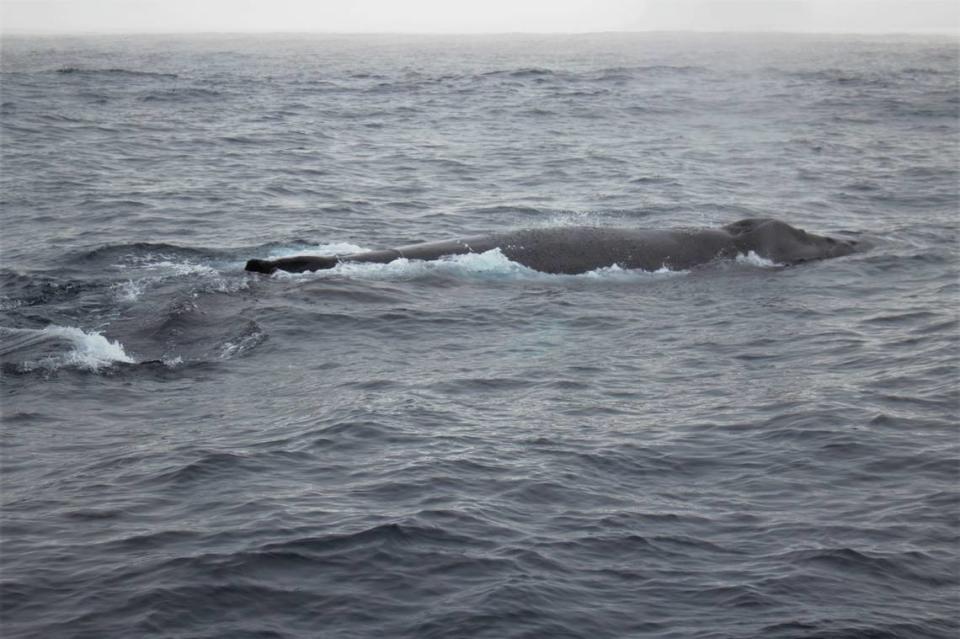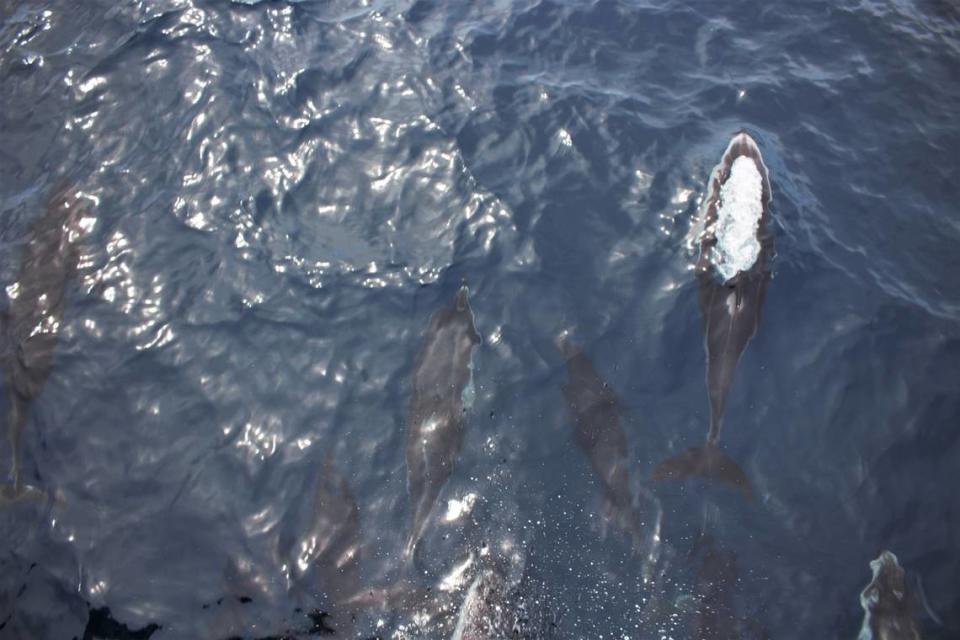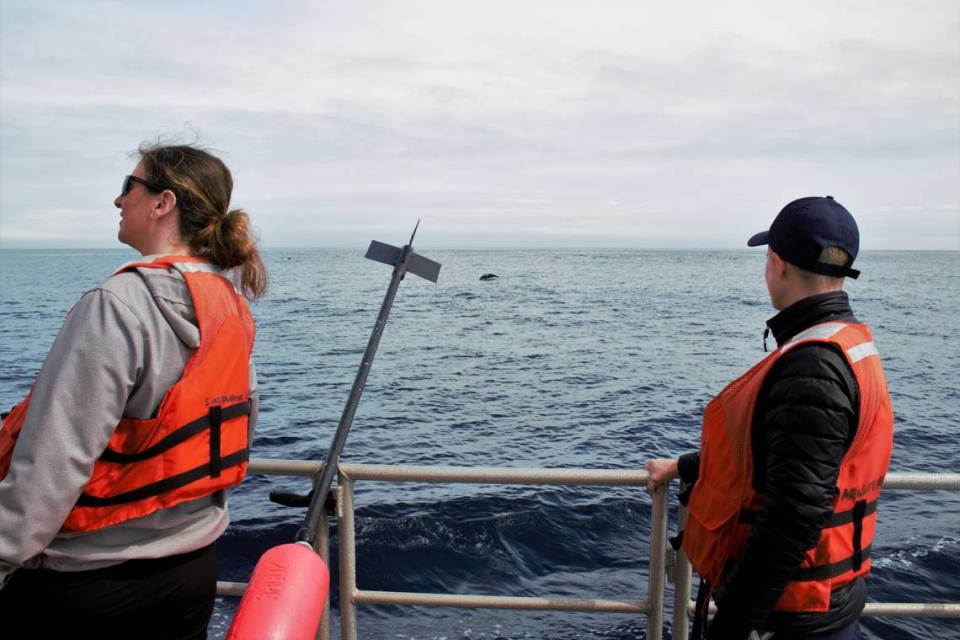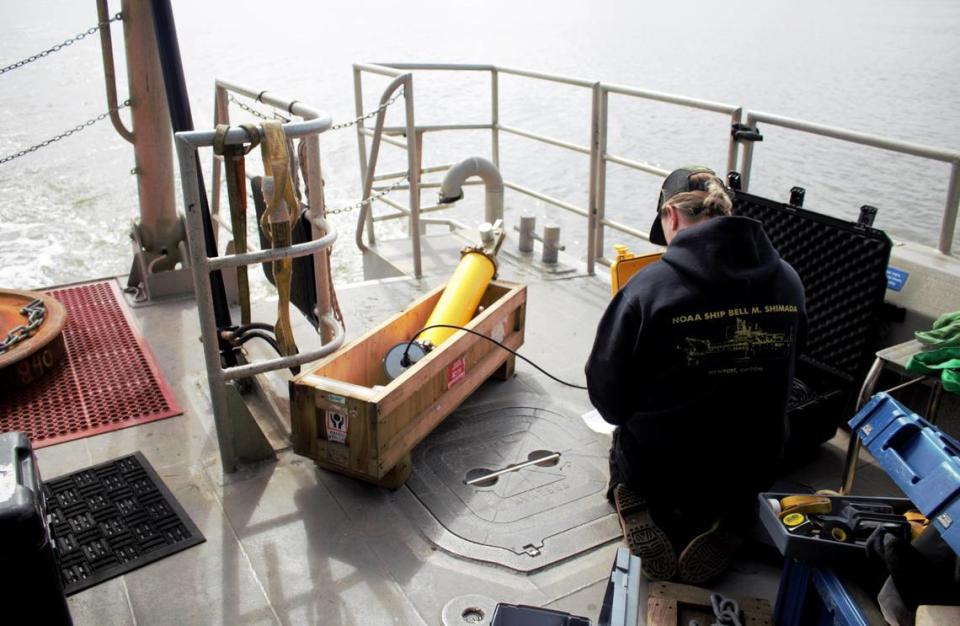How could offshore wind impact marine life off SLO County coast? Experts listen for answers
More than a dozen miles off California’s Central Coast on a foggy March morning, a federal government research vessel charged through the deep blue waters of the Pacific Ocean.
Suddenly, one of the National Oceanic and Atmospheric Administration scientists aboard the Shearwater pointed out a fleeting splash of water disturbing the ocean’s surface.
“Dolphins!” exclaimed Kaitlin Palmer, one of seven members of the all-woman research team. The boat’s captain slowed the NOAA Research Vessel Shearwater down as the vessel drew closer to the pod.
What followed next was a frenzied dash to document the Pacific white-sided and Northern right whale dolphins the scientists had stumbled upon. Soon, two humpback whales were spotted swimming among the large pod of dolphins.
After taking time to gawk at the stunning marine mammals, Palmer and another NOAA scientist, Anne Simonis, quickly deployed a sound recorder attached to a floating buoy next to the pod of dolphins and two whales.
The underwater sound recorder is part of efforts by the federal government to better understand marine life off San Luis Obispo County’s coast before major floating offshore wind energy development begins there.

Concerns about the offshore wind industry’s impact on marine life have been recently raised on the East Coast, as companies work to survey the ocean floor there before submitting construction plans. In claims that are now thoroughly debunked, coastal communities in the region blamed the energy companies for the dead whales washing up on their beaches.
Similar survey activities have yet to start on the West Coast, where the Humboldt Bay and Morro Bay areas were auctioned off for a collective $757 million to provisional leaseholders in December.
Those activities likely won’t start for several months — after the U.S. Bureau of Ocean Energy Management issues final leases to the five winning companies.
“We’re trying to do our very best to anticipate the potential impacts,” said Desray Reeb, a marine biologist for BOEM. “We’re trying to put science in place and get the answers that we need as quickly as we can in order to ensure that the impacts that we are introducing (offshore wind) are minimized or avoided at every possible avenue.”

How could offshore wind energy impact marine life?
Located about 20 miles off the coast of Cambria and San Simeon, the Morro Bay offshore wind energy area covers 376 square miles of the Pacific Ocean.
That’s equivalent to more than 10% of the area of San Luis Obispo County, or nearly 14% of the entire Los Padres National Forest.
Should it be fully developed with hundreds of 1,100-foot-tall wind turbines, the three companies that won the winning bids estimate they can generate a collective 6 gigawatts of electricity at peak production — enough to power more than 2 million homes.
In comparison, the largest floating wind farm in the world — Equinor’s Hywind Tampen located off the coast of Norway — produces 88 megawatts of electricity. That’s just 1.5% of the Morro Bay wind energy area’s potential peak production.
Floating wind turbines are expected to be in the ocean off the San Luis Obispo County coast by 2030, according to federal officials.

Little is known about floating offshore wind energy’s impact on marine life.
NOAA estimates the ocean development could have a number of significant effects on the ocean.
Its website lists a few, including increasing ocean noise, which could affect the behaviors of fish, whales and other species, and introducing electromagnetic fields that impact navigation, predator detection, communication and the ability for fish and shellfish to find mates.
According to NOAA, offshore wind energy production could also change existing habitats by altering local or regional hydrodynamics; creating a so-called “reef effect” where marine life cluster around the hard surfaces of wind developments and impact organisms’ life cycle stages, including spawning.
It could also change species composition, abundance, distribution and survival rates, the agency said, in addition to increasing vessel traffic, which could lead to more vessel strikes, and releasing contaminants that can be consumed or absorbed by marine life.

Acoustic research aims to uncover ocean air
According to Lindsey Peavey, one of the NOAA scientists onboard during the early March research mission, the ocean area proposed as a site for the Morro Bay area development is “harder to access” compared to other areas along California’s coast.
That means it is notoriously understudied, she explained.
NOAA and BOEM are gathering what the scientists call “baseline data” to figure out what the ocean in the Morro Bay wind energy area is like before any offshore wind development happens.
One important aspect is acoustics research, or essentially listening to the ocean to hear what animals are traveling within its depths.
In early March, Simonis and her Adrift team deployed eight floating buoys with attached sound recorders in the northern end of the Morro Bay wind energy area. The team is under the umbrella of NOAA’s Southwest Acoustic Ecology Lab.

Those eight buoys send data pings about once every 30 minutes and are tracked by satellite transmitters. They’ll float in the ocean for up to a month before the scientists retrieve them to listen to the sounds recorded.
The sounds “will tell us what animals are present and where they are,” Simonis said.
Blue whales, humpback whales, gray whales and sperm whales are a few of the species that are known to travel through the Central Coast area in search of food or toward breeding areas.
Each of those whales has distinct calls that they use to communicate with each other and to find food, breed and travel.
When the Adrift team encountered dolphins and humpback whales during the March research mission, Simonis and her fellow researchers seized the chance to gather data on the sounds those animals make and deployed one of their seven-pound sound recorders.

Once set into the water, the buoy drifted away for about 30 minutes before the NOAA research boat navigated back to it and Palmer and Simonis brought it back on board.
On the same trip, Lauren Roche, an acoustics researcher with NOAA’s Pacific Marine Environmental Laboratory, deployed a sound recorder within the proposed Chumash Heritage National Marine Sanctuary and just south of the Morro Bay wind energy area.
Her 150-pound sound recorder was attached to a train wheel on a cord to anchor it to the bottom of the 900-meter-deep seafloor. It’ll stay in the ocean for about two years, gathering low-frequency sounds of passing marine animals, ships and other underwater noises that may occur in that area.
Roche’s recorder is the 13th NOAA ocean noise reference station to be deployed in the United States.
The two closest to it are in the Cordell Bank National Marine Sanctuary, located offshore from Point Reyes in Marin County, and the Channel Islands National Marine Sanctuary off the Santa Barbara coast.
“This is a really exciting location for us,” Peavey said of the proposed Chumash Heritage National Marine Sanctuary site. “We’re filling a huge data gap and getting baseline data ahead of the potential increase in vessel traffic from offshore wind activities.”

The Adrift team also deployed drifting buoys in the same Morro Bay wind energy area in June 2022. The team is going back again in July and November to repeat the research mission.
Repeating the study during a different time of year provides a clearer picture of which animals are swimming through the wind energy area at certain times, the researchers explained.
Aside from the acoustics research, BOEM is actively partnering with NOAA, the U.S. Navy, U.S. Fish and Wildlife Service and other federal agencies in the Pacific Marine Assessment Program for Protected Species, or PacMAPPS.
As part of the assessment program, the federal agencies have looked for marine species, taken photographs and collected biopsies to identify which animals are along the California coast, Reeb said.

Offshore wind companies must follow safety protocols
When the offshore wind energy companies begin their survey work off the Central Coast to inform their construction plans, they must follow rules set forth by BOEM in their lease, Reeb said.
BOEM will require the survey boats to have certified protected species observers onboard to monitor for certain animals that may come near.
The federal agency could also mandate that the boats avoid certain areas if a high number of protected species appear to congregate there, she added.
The end goal is to attempt to minimize the harm caused to marine life by increased vessel traffic and ocean industrialization, Reeb said.
“People see offshore wind developments as adding to a pristine situation, and that’s not really true,” she said. “The Earth has already changed. The environment is changing, and it’s changing more rapidly than we can keep up with.”
“With the climate change issue that we’re facing and our reliance on diversifying our energy resources, offshore wind provides a really interesting opportunity for us,” she continued. “BOEM is trying to answer that call in an environmentally responsible way.”


